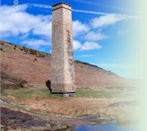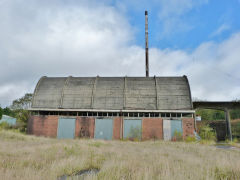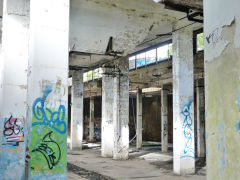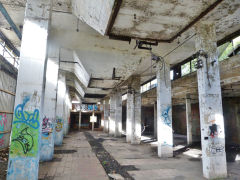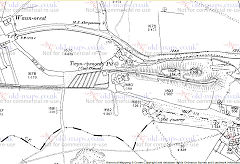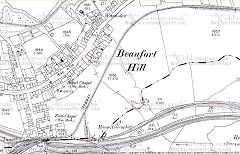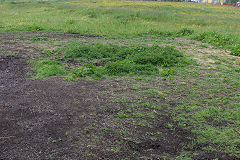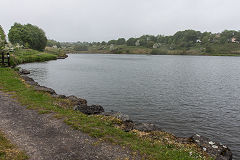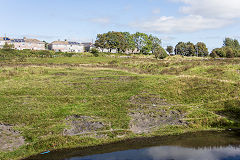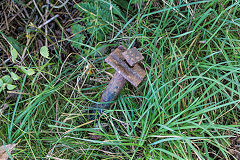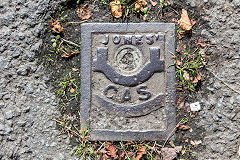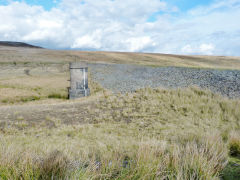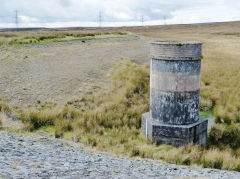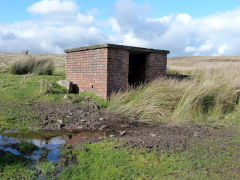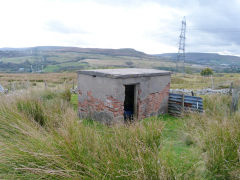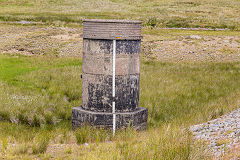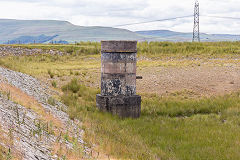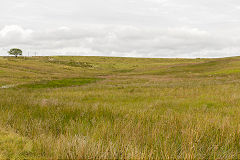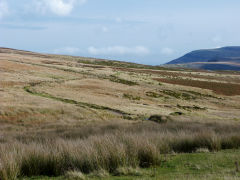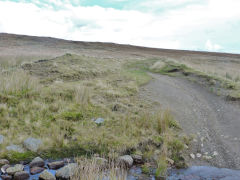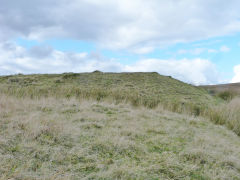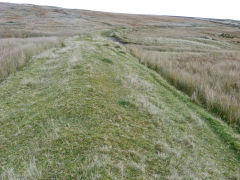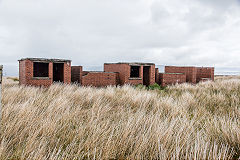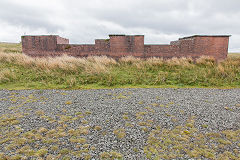The Industrial Archaeology and History of the Western Valley
Or click on the button to go to :-
Click on the thumbnail to enlarge a photo or map and sometimes read more about it.
Then click 'Full Size' on the toolbar to see it in all its glory.
Railways and Tramroads
Three mainline railways met at Brynmawr, two GWR branchlines, one up the Western Valley from Aberbeeg, the other over the top from Blaenavon, and the MTAR (LNWR) line from Abergavenny to Merthyr. Thrown into the mix were a whole cat's cradle of tramroads, railroads and minor tramways. But there's not a lot left!
The MTAR from Abergavenny to Merthyr - SO 1873 1150
Brynmawr West Junction was where the GWR branch to Nantyglo, Abertillery and Aberbeeg curved off from the MTAR. Underneath both lines ran the Disgwylfa Tramroad, which linked the limestone quarries at Disgwylfa with Nantyglo Ironworks.
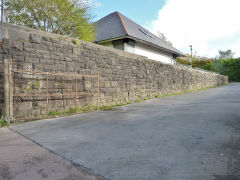
Retaining wall under Platform 4
|
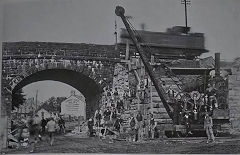
Bridge over Blaina Road
|
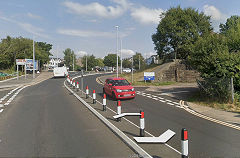
Bridge over Blaina Road
|
|
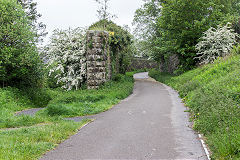
Western Valley Junction, MTAR
|
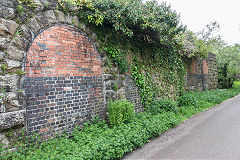
Western Valley Junction, MTAR
|
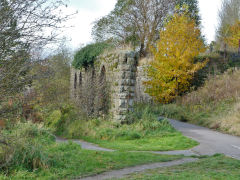
Western Valley Junction, MTAR
|
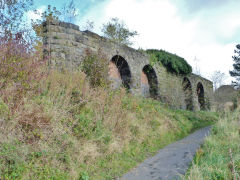
Western Valley Junction, MTAR
|
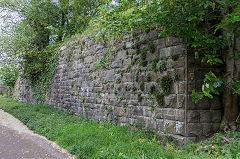
Western Valley Junction, MTAR
|
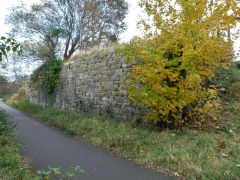
Western Valley Junction, MTAR
|
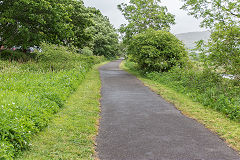
The MTAR towards Brynmawr
|
|
The GWR to Abertillery - SO 1873 1150
The GWR branch to Nantyglo, Abertillery and Aberbeeg curved off from the MTAR at Brynmawr West Junction. It was only open from 1906 to 1963. You can follow it from the junction to Pond Road but a lot of it has been used for the main road from there down to Abertillery.
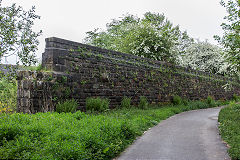
Western Valley Junction, GWR
|
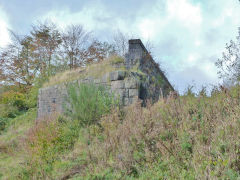
Western Valley Junction, GWR
|
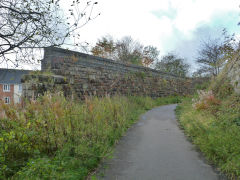
Western Valley Junction, GWR
|

The GWR trackbed to Nantyglo
|
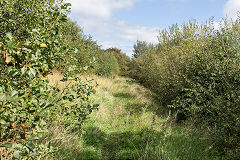
The GWR trackbed to Nantyglo
|
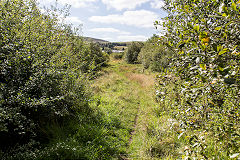
The GWR trackbed to Nantyglo
|
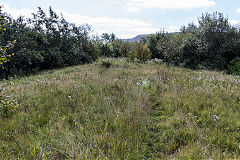
The GWR trackbed to Nantyglo
|
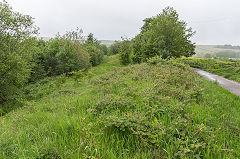
The GWR trackbed to Nantyglo
|
Disgwylfa Tramroad
The 2'4" gauge Disgwylfa Tramroad ran from Baileys Nantyglo Ironworks to the limestone quarries at Disgwylfa on Llangattock Mountain. It probably worked from c1810 to c1870. The parts of the route below the MTA railway line and also between the Clydach bridge and Cairn Mound have completely disappeared but the rest of the line makes an excellent walk.
This journey along the line starts at Welfare Park and ends near the point where the tramroad crossed the Clydach river. A garden beside the line in Clydach Street has been landscaped in its memory.
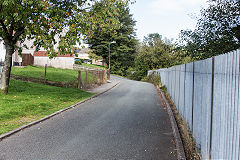
Tramroad at Welfare Park
|
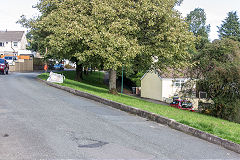
Tramroad at Park Crescent
|

Tramroad at Windsor Road
|
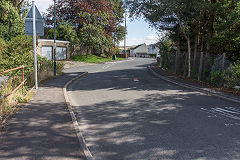
Tramroad at Windsor Road
|

Tramroad at Well Street
|
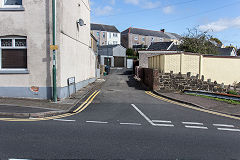
Tramroad at Well Street
|

Tramroad at Well Street
|

Tramroad crossing King Street
|

Tramroad along Clydach Street
|

Tramroad along Clydach Street
|
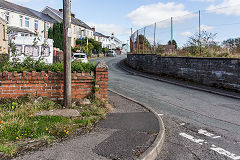
Tramroad along Clydach Street
|

Tramroad along Clydach Street
|
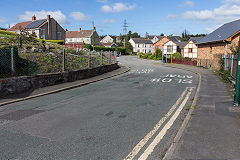
Tramroad along Clydach Street
|

Tramroad along Clydach Street
|

Tramroad along Clydach Street
|
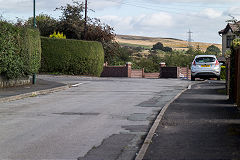
Tramroad along Clydach Street
|
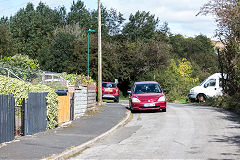
Tramroad along Clydach Street
|
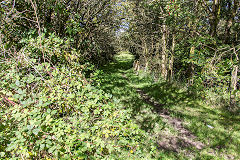
Tramroad to the Clydach bridge
|
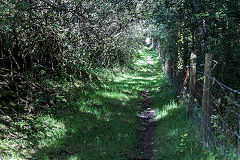
Tramroad to the Clydach bridge
|

Tramroad to the Clydach bridge
|

Tramroad to the Clydach bridge
|
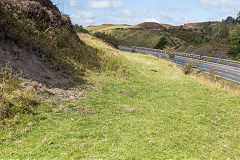
Tramroad to the Clydach bridge
|
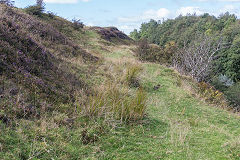
Tramroad to the Clydach bridge
|
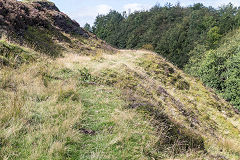
Tramroad to the Clydach bridge
|
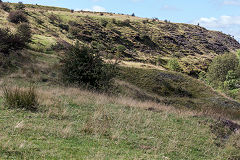
Tramroad to the Clydach bridge
|
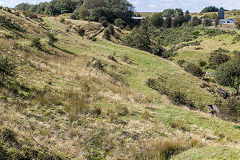
Tramroad to the Clydach bridge
|
|
|
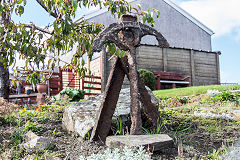
Disgwylfa Tramroad garden
|
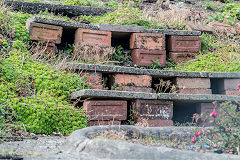
Disgwylfa Tramroad garden
|
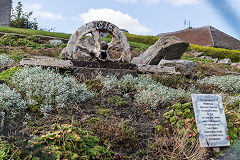
Disgwylfa Tramroad garden
|
|
Llangattock Tramroad
The 3'6" gauge Llangattock Tramroad ran from Baileys Nantyglo Ironworks to the large quarries above Llangattock, connecting with the nclines and tramroad down to the B&A canal. It was constructed in c1830 to c1875 and operated by one or two steam locomotives from the start, followed by 'Cymro', built by the Uskside Ironworks, Newport, in c1860.
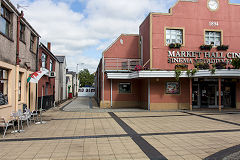
Tramroad at Lower Bailey Street
|

Tramroad at Lower Bailey Street
|
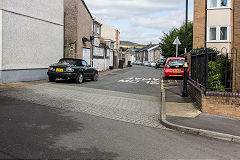
Tramroad at Lower Bailey Street
|
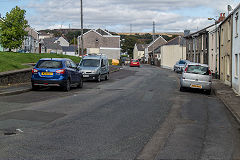
Tramroad at Lower Bailey Street
|

Tramroad at Lower Bailey Street
|
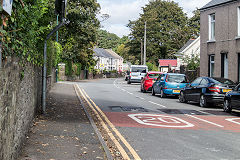
Tramroad at Intermediate Road
|
|
|
Baileys tramroad sidings - SO 1916 1163
A collection of sidings existed in Catholic Road seemingly linking the three Bailey tramroads. It's quite possible they were converted to railways and connected to the MTAR near Brynmawr East Junction as they are referred to as 'Bailey Siding' on the 1920 map.
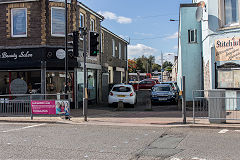
Baileys tramroad sidings
|
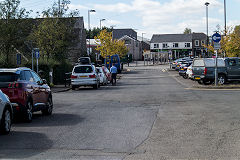
Baileys tramroad sidings
|
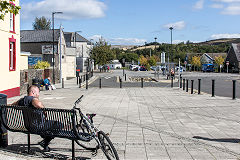
Baileys tramroad sidings
|
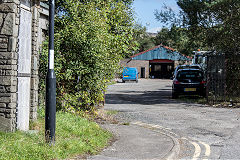
Baileys tramroad sidings
|
Clydach Railroad
The 3'8" gauge Clydach Railroad dates from 1793 and was little used by 1865 but short sections may still have been used into the 20th century, It ran from Glangrwyney Forge through Gilwern and Brynmawr to Kendalls Beaufort Ironworks.
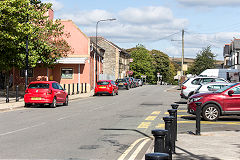
The Railroad along Alma Street
|

The Railroad along Alma Street
|
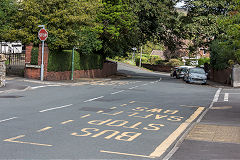
The Railroad along Alma Street
|
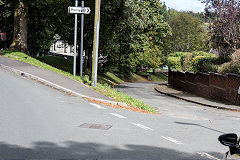
The Railroad along Alma Street
|
1833 tramroads to Beaufort Ironworks
The Baileys of Nantyglo Ironworks purchased the Beaufort Ironworks from the Kendalls in 1833 and established a tramroad between Beaufort Ironworks and the Llangattock Tramroad and also between the two ironworks.
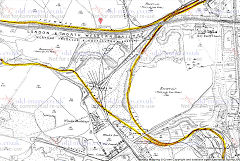
West Brynmawr tramroads, 1880
|
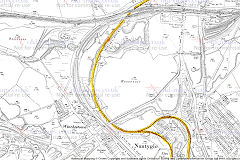
West Brynmawr tramroads, 1920
|
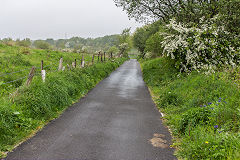
Nantyglo to Beaufort link
|
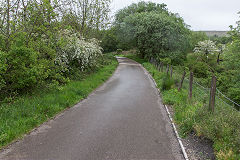
Disgwylfa Tramroad at Winches Pit
|
The LNWR Blaenavon branch
Opened in 1869, the railway between Brynmawr and Blaenavon closed to both goods and passengers in 1954. The line from Waunavon to Blaenavon re-opened for opencast mining traffic but this work at the Brynmawr end also destroyed the original trackbed. One survivor is this tramway tunnel under the line that joined small levels to the Clydach Railroad at Greenland Road. The modern footpath follows the railway route quite closely and, with a little imagination, the line can still be found. The section around Waunavon is covered in more detail on the Blaenavon pages here :-
Forgeside to Waunavon
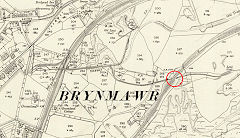
Tramway under the Blaenavon Branch
|
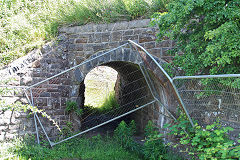
Tramway under the Blaenavon Branch
|
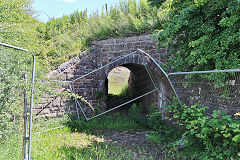
Tramway under the Blaenavon Branch
|
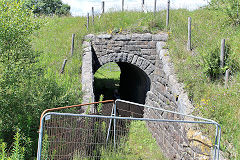
Tramway under the Blaenavon Branch
|
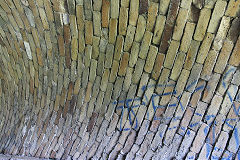
Tramway under the Blaenavon Branch
|

Blaenavon Branch above the tunnel
|
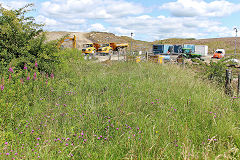
Blaenavon Branch above the tunnel
|
|
Clydach Dingle
Rhas Fach and the Patches - SO 1865 1275
Rhas Fach and the Patches is the area to the North of Brynmawr town up to the A465 Heads of the Valley Road. You can follow the course of the Disgwylfa Tramroad from Clydach Street until it disappears under the A465. No sign of the stone sleepers which I've heard are here, but I did come across a Royal Observer Corps lookout post, in use from 1962 to 1973, on the hill above. Rhas Fach (Little Race) was an area of very old scourings, quarries and mine workings for both coal and ironstone with a small community near the ponds.
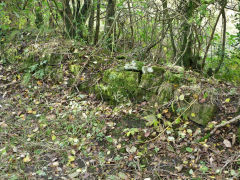
Disgwylfa Tramroad, Brynmawr
|
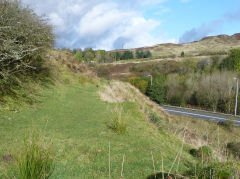
Disgwylfa Tramroad, Brynmawr
|
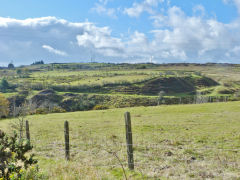
Disgwylfa Tramroad, Brynmawr
|
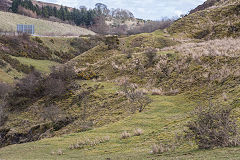
Tramroad near Rhas Fach
|
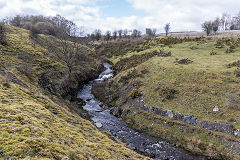
Tramroad near Rhas Fach
|
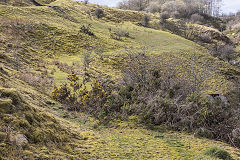
Tramroad near Rhas Fach
|
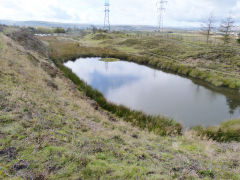
Rhas Fach ponds
|
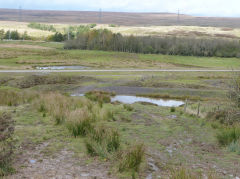
Rhas Fach ponds
|
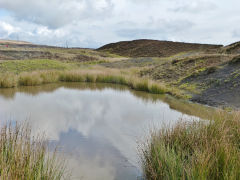
Rhas Fach ponds
|
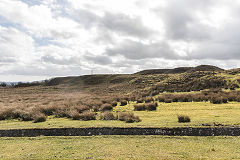
Rhas Fach Patches
|
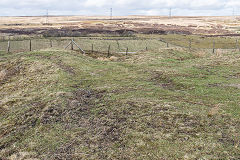
Rhas Fach Patches
|
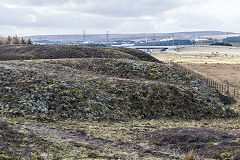
Rhas Fach Patches
|
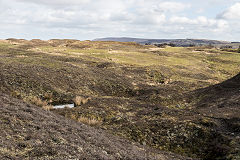
Rhas Fach Patches
|
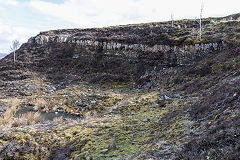
Rhas Fach Patches
|
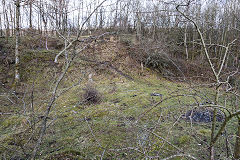
Site of Rhas Fach cottages
|
|
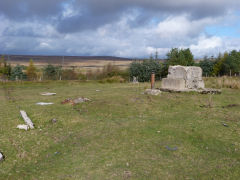
ROC underground bunker
|
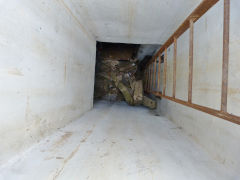
ROC underground bunker
|
|
|
Clydach Street tips - SO 1890 1240
The South side of Clydach Dingle was extensively worked for ironstone and coal from the mid 1700s. Two branches from the Disgwylfa Tramroad ventured up into the workings from Clydach Street, one serving the lower workings left the tramroad at SO 1898 1221 and the other serving the middle workings at SO 1917 1240.
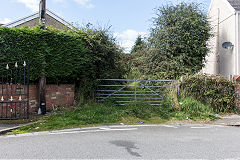
Tramroad to the lower workings
|
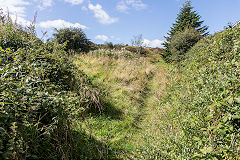
Tramroad to the lower workings
|

Workings off Clydach Street
|
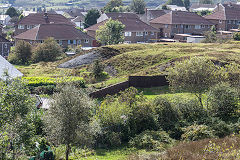
Workings off Clydach Street
|

Workings off Clydach Street
|
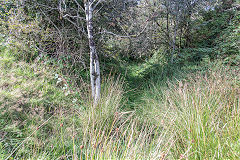
Workings off Clydach Street
|
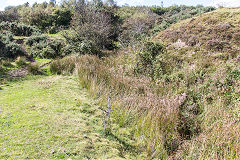
Workings off Clydach Street
|
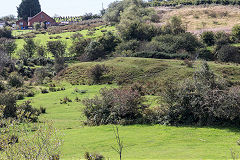
Workings off Clydach Street
|

Lower level tips
|
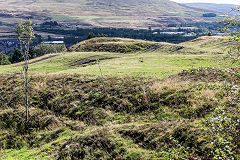
Middle level tips
|
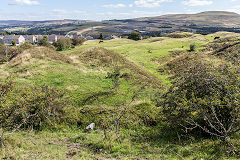
Middle level tips
|
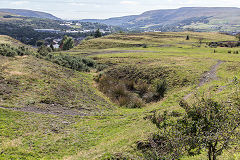
Middle level tips
|
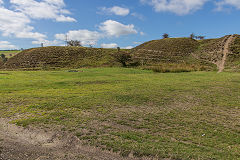
Middle level tips
|
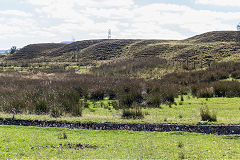
High level tips
|
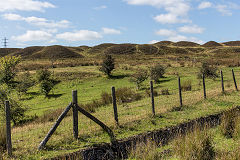
High level tips
|
|
Blaen Clydach
Behind the Blaen-y-Cwm reservoir are a number of coal and ironstone levels that were connected by a tramway to Rhas-fach where it connected with the Garnlydan Tramway, Disgwylfa Tramroad and the Clydach Railroad. There is a string of water-filled pits with tips behind them, once coal levels with one larger pit to the East. Here there are the remains of a small building, once used by the colliery but appears to be more recently used as a bunker or markers hut for the rifle range along with nearby butts. Little remains of Redvein Level but the tramway can be seen from the hillside above. Most of the workings were disused by the 1890s.
Keith Phillips remembers :- 'Bill Gascoigne from the college and Brynmawr caving club did a survey of the Western level and said it was late 18 century, the only way in was thro a sink hole which flooded when raining. There were wooden clogs and candle holders carved into the rock. Very interesting. Although we were disappointed as we thought it was a back way into Agen Allwydd (aggie) in Llangattock. When inside you can see 2 shafts dug at about 45° totally flooded with clear water, even though every thing around is dark red from the oxide'.
Geoff Palfrey reports :- 'The area was a hushing pond for Beaufort Ironworks, scouring shales from the open pits exposing from the south the old coal seam, the spotted vein of ore, the red vein of ore and the bottom vein of ore, then the big vein, or Garw seam is its now known, North of these are thin ore and coal seams known as Rosser seams after an early miner called Rosser who took ore from the area for the furnace in Brecon. The area was called Clydach terraces. As the overburden became thicker the mines went underground. The patch system of contracting was used, the mineral agent hired a contractor who paid the wages of the miners, they used gunpowder barrows and pick and shovels to get to the minerals, girls and women barrowed the ore making the fan shaped shake tips. The ore was sold in what was termed dozens or twelve bushels equivalent to a ton and a half. When The Baileys purchased Beaufort ironworks they found that a localized blackband of self calcining ore was in the strata and had been discarded, huts being built for the workers from it. The Scots Ironmaster Mushet has used this in Scotland, the Baileys maintained they discovered its use prior. The huts were trammed to the furnaces and the black band ore calcined on site, the Beaufort iron was made cheaply due to this. By 1878 Nantyglo and Beaufort were closed, Nantyglo having thousands of tons of ore at bank. The EV co stopped using Welsh mine by 1878, it’s metallisation was low at around 30 percent and better ores were available from Cumbria, Ireland and Spain, as well as the mines of Somerset. After closure leases were provided to small local coal merchants and they picked the bones of what was left of the coal, Bryn Pit, by layout was used to lower the trams of mine ore, probably to join to the balance engine of Winchs pits. Bryn ended its days of mining lowering coal from a level near slam gate, probably taking coal to Beaufort yard. The Cinder pit did the same in the 1880’s from Tunnel pits. The reservoir was used and extended twice, first by the EV Co around WW1, then in the mid 1930s for RTB works, this became a costly embarrassment because the reservoir extension would not fill due to the honeycombed workings below it, they had to be bashed off and the cost added to the works budget, causing director Lever to lose the banks confidence and he had to leave.'
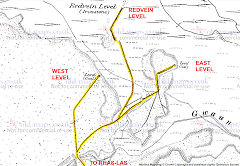
Blaen Clydach levels, 1880
|
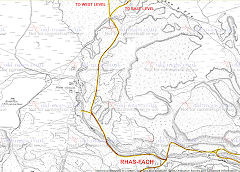
Blaen Clydach tramway, 1880
|

Blaen Clydach Eastern level
|
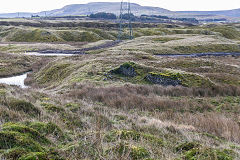
Eastern level building
|
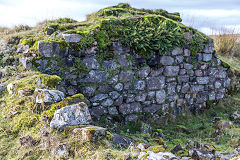
Eastern level building
|
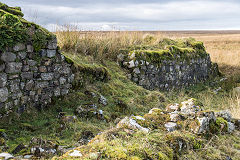
Eastern level building
|
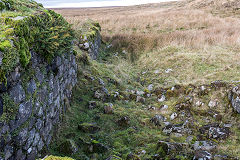
Eastern level building
|
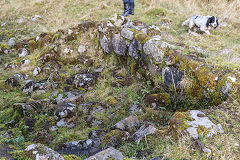
Eastern level building
|
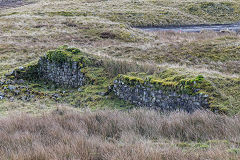
Eastern level building
|
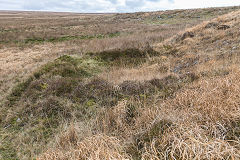
Eastern level foundations
|
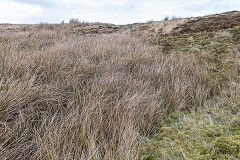
Blaen Clydach Redvein Level
|
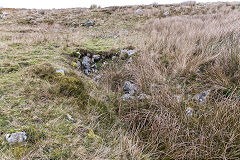
Blaen Clydach Redvein Level
|
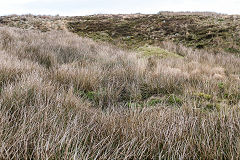
Blaen Clydach Redvein Level
|
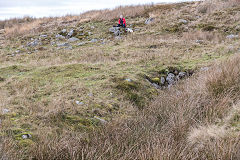
Blaen Clydach Redvein Level
|
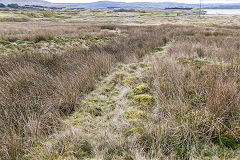
Redvein Level tramway
|
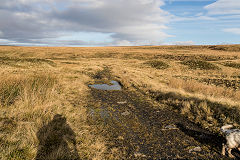
Western level tramway
|
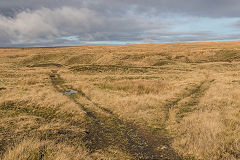
Western level tramway
|
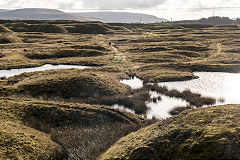
Western level
|

Western level tips
|
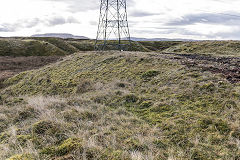
Western level tips
|
Clydach Terrace - SO 1900 1315
The headwaters of the Clydach River as it emerges below Blaen-y-cwm Reservoir into Clydach Dingle, an area of very ancient workings.
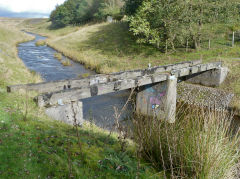
Below Blaen-y-Cwm Reservoir
|
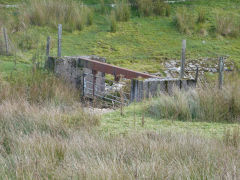
Below Blaen-y-Cwm Reservoir
|
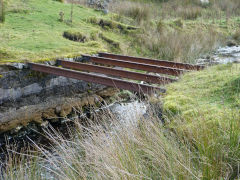
Below Blaen-y-Cwm Reservoir
|
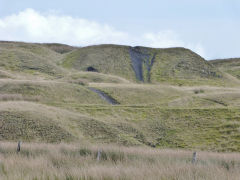
Patches near Blaen-y-Cwm Reservoir
|
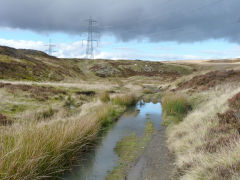
Around Clydach Terrace
|
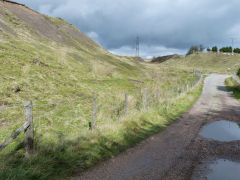
Around Clydach Terrace
|
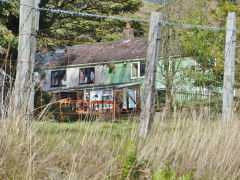
Around Clydach Terrace
|
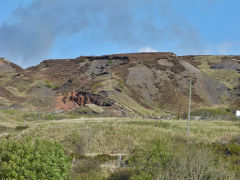
Around Clydach Terrace
|
Acknowledgments, sources and further reading
Thanks for addition information to :- Karl Jones, Geoff Palfrey, Keith Phillips
For more information on Brynmawr' history :-
Brynmawr Historical Society
or Blaenau Gwent's heritage :-
Blaenau Gwent Heritage Forum
A Guide to the Website
Industrial Wales
Collieries, Ironworks, Quarries, Railways, Canals, Tramroads, Tunnels, Culverts and so much more....
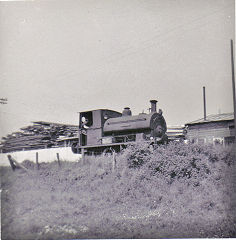
|
Brickworks of Wales
Bricks are 'History with a label' so here's the story of the Brickworks of Wales - photos, maps and the products themselves
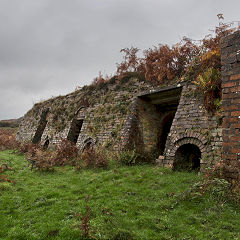
|
Around the World
My travels around the UK and the Whole Wide World in search of industries, railways, trams and mines to name a few.
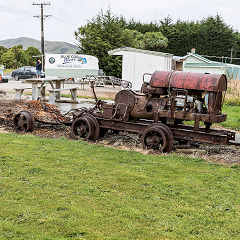
|
Boundary Stones and Mileposts
Boundary Stones, Mileposts and other markers in simple alphabetical order of their initials, name or site.

|
Ships and Shipping
Ships around the World in simple alphabetical order of their name (or apparent area if I can't read the name).

|
The Site Map and Index
A full list of all the pages of the whole website in just one place, so you should find exactly what you are looking for.
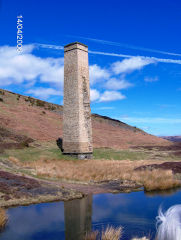
|
About the Site
The background and technical details about the site, plus a contact page and links to other sites - and a warning !!

|
Contact Me
Something to add? A great photo? Something wrong? or need to know more about things? Just drop me a line here.

|
Further Reading
You can find lots of local and other very helpful websites, books, magazines and Facebook groups all listed here.
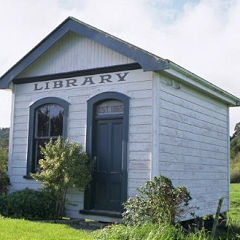
|
All rights reserved - Phil Jenkins
